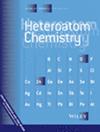An easy synthetic protocol for imidazo-1,4-oxazines and evaluation of their toxicities
IF 1.1
4区 化学
Q3 CHEMISTRY, MULTIDISCIPLINARY
引用次数: 9
Abstract
Imidazo-1,5-alkynyl alcohol derivatives were synthesized, and they were cyclized to imidazo-1,4-oxazines by means of cesium carbonate. Propargyl-allene isomerization was examined, and the reaction mechanism was proposed. Moreover, cytotoxicity of synthesized molecules against LN405 cell lines was investigated by means of structure-activity relationship (SAR). With SAR study, toxicities of some functional groups have been shown. In addition, two lead compounds were tested against DNA damaging.
咪唑-1,4-恶嗪的简易合成方法及其毒性评价
合成了咪唑-1,5-炔醇衍生物,并以碳酸铯环化得到咪唑-1,4-恶嗪。研究了丙炔与丙烯的异构化反应,并提出了反应机理。此外,利用构效关系(SAR)研究了合成的分子对LN405细胞株的细胞毒性。在SAR研究中,一些官能团的毒性已被证实。此外,还对两种先导化合物进行了DNA损伤测试。
本文章由计算机程序翻译,如有差异,请以英文原文为准。
求助全文
约1分钟内获得全文
求助全文
来源期刊

Heteroatom Chemistry
化学-化学综合
CiteScore
1.20
自引率
0.00%
发文量
5
审稿时长
6 months
期刊介绍:
Heteroatom Chemistry brings together a broad, interdisciplinary group of chemists who work with compounds containing main-group elements of groups 13 through 17 of the Periodic Table, and certain other related elements. The fundamental reactivity under investigation should, in all cases, be concentrated about the heteroatoms. It does not matter whether the compounds being studied are acyclic or cyclic; saturated or unsaturated; monomeric, polymeric or solid state in nature; inorganic, organic, or naturally occurring, so long as the heteroatom is playing an essential role. Computational, experimental, and combined studies are equally welcome.
Subject areas include (but are by no means limited to):
-Reactivity about heteroatoms for accessing new products or synthetic pathways
-Unusual valency main-group element compounds and their properties
-Highly strained (e.g. bridged) main-group element compounds and their properties
-Photochemical or thermal cleavage of heteroatom bonds and the resulting reactivity
-Uncommon and structurally interesting heteroatom-containing species (including those containing multiple bonds and catenation)
-Stereochemistry of compounds due to the presence of heteroatoms
-Neighboring group effects of heteroatoms on the properties of compounds
-Main-group element compounds as analogues of transition metal compounds
-Variations and new results from established and named reactions (including Wittig, Kabachnik–Fields, Pudovik, Arbuzov, Hirao, and Mitsunobu)
-Catalysis and green syntheses enabled by heteroatoms and their chemistry
-Applications of compounds where the heteroatom plays a critical role.
In addition to original research articles on heteroatom chemistry, the journal welcomes focused review articles that examine the state of the art, identify emerging trends, and suggest future directions for developing fields.
 求助内容:
求助内容: 应助结果提醒方式:
应助结果提醒方式:


